Your chickens will need properly formulated chicken feed that is the correct type for their age, for growth, sustenance and to produce eggs if they are hens of egg laying age. There are many old wives tales and alternative views on feeding, some say it’s marketing that has created all of these feeds and hens will survive well on wheat and others will say their grandad never had layers pellets and just fed his hens kitchen scraps! Formulated poultry feeds didn’t exist until recently, primarily created thanks to commercial research on hens diets as we tried to squeeze more and more eggs out of hens.
In days gone by though when ‘grandad fed scraps’, pure breeds were kept for eggs and they were fed grain mixes or dried mash chicken feed that had meat or fish meal added to increase the protein content. Hens would free range over a large area and could also supplement their diet with what they could forage. Bugs, insects and worms are all valuable sources of protein, not forgetting a good selection of greens providing vitamins and minerals.
“Grandad’s chickens didn’t get chicken feed and survived on kitchen scraps but they could free range to top up their diet on protein, vitamins, minerals and calcium from the fields or orchards they grazed. They didn’t produce anything like the number of eggs modern hybrid hens or some pure breeds produce.”
So in short, if you don’t feed a proper formulated layers feed to your hens, they won’t be able to keep up the demands that egg-laying puts on their bodies.
Layers Feeds and Protein
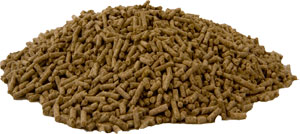 Chickens require protein to produce feathers and eggs as well as to grow. The amount of protein in their diet is important and you will see on the ingredients on the back of bags of commercial feeds the percentage of protein that they contain. It is higher in ‘Growers Pellets’ for example to enable chickens to grow and produce feathers. You will find that chickens stop laying eggs when they moult (lose their feathers and regrow new) as they are diverting protein from egg production to feather production. During the moult, you can scatter a handful of cat kibble in the run which helps them to top up with protein. Do not use dog food as most of the protein is derived from cereals.
Chickens require protein to produce feathers and eggs as well as to grow. The amount of protein in their diet is important and you will see on the ingredients on the back of bags of commercial feeds the percentage of protein that they contain. It is higher in ‘Growers Pellets’ for example to enable chickens to grow and produce feathers. You will find that chickens stop laying eggs when they moult (lose their feathers and regrow new) as they are diverting protein from egg production to feather production. During the moult, you can scatter a handful of cat kibble in the run which helps them to top up with protein. Do not use dog food as most of the protein is derived from cereals.
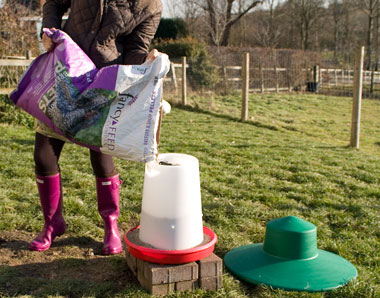
Commercial feeds contain the right balance of nutrients & can be fed ad-lib in hoppers if kept dry. This one has a rain hat.
Commercial chicken feeds have been well researched and contain the correct balance of minerals and nutriets required by chickens as well as sufficient protein and calcium which is essential for egg shell production. Layers pellets for example are around 16% protein. Wheat is about 10% protein and lacks essential vitamins that are required by chickens.
Formulated feeds come as pellets or mash and should be fed ad-lib so hens can take what they want as they need it. This type of feed must be kept dry or it will soon spoil. The feeder and rain hat shown above is the only sort I have found that really does keep the feed dry. Most have a hole in the top of the hat for a handle or for hanging and this lets water in. A feeder and rain hat similar to this one can be bought from Omlet.
Eggs are made up of around 80% protein so if there’s a shortage of protein in their diet, egg laying will be the first thing they your girls cut back on!
There is more information on the poultykeeper.com site which has a very good page of feeding chickens and chicken feed.
Mixed corn
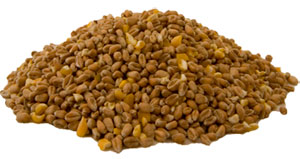 Mixed corn is usually 80 to 90% wheat and 10 to 20% maize. It is useful as a scratch feed, it keeps hens active, scratching around looking for it but should only be considered a treat. A handful per hen thrown late afternoon helps them to have a full crop overnight.
Mixed corn is usually 80 to 90% wheat and 10 to 20% maize. It is useful as a scratch feed, it keeps hens active, scratching around looking for it but should only be considered a treat. A handful per hen thrown late afternoon helps them to have a full crop overnight.
The maize (yellow in colour) is very fattening but can be useful during very cold weather to help your hens keep warm – I increase my girls’ ration of corn when it is cold over the winter, after they have finished moulting (they need lots of protein during the moult) since they are not laying eggs and need a little extra fat to burn in order to keep warm.
If you feed too much corn, your hens will get fat and fat hens don’t lay eggs!
Household scraps
Feeding household scraps is no longer allowed according toi DEFRA and can be a bit hit and miss anyway. You don’t really know what a hen is getting and the diet is very unbalanced. It is for this reason that scraps used to be mixed into a mash by using layers mash and water (which can be warm in winter). The mixture should be a sort of crumbly mix, not too wet but not too dry. Feeding scraps should be limited to at most 25% of a hens diet so as not to tip the balance too far one way or another.
Greens
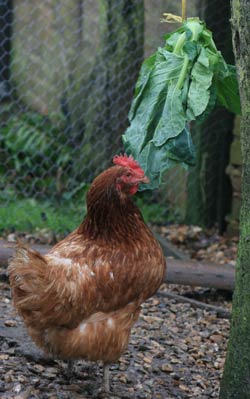 Ample green stuff should be provided for your hens. Grass cuttings, weeds and off-cuts from cabbages, cauliflowers and other greens can be provided at minimal cost. Lettuce should be fed in moderation because it has very little nutritional value (very little Protein and Energy / Calories) and avocado pear is poisonous to hens but most other greens that come from the kitchen will be appreciated by your girls. Try hanging greens in their run, just a little higher than they can reach. As they eat them, they will need to jump to get the last bits so will be getting exercise at the same time as their greens! Win-win!
Ample green stuff should be provided for your hens. Grass cuttings, weeds and off-cuts from cabbages, cauliflowers and other greens can be provided at minimal cost. Lettuce should be fed in moderation because it has very little nutritional value (very little Protein and Energy / Calories) and avocado pear is poisonous to hens but most other greens that come from the kitchen will be appreciated by your girls. Try hanging greens in their run, just a little higher than they can reach. As they eat them, they will need to jump to get the last bits so will be getting exercise at the same time as their greens! Win-win!
If you have an area in which you can grow cabbages in your garden, it may be worthwhile thinking about growing a row for the winter. Cabbages will sit there in the cold, perfectly preserved until picked. You will need to keep them covered with fleece when there are cabbage white butterflies around but don’t worry if they are a little eaten, the chooks won’t mind!
Mealworm treats
Many chicken keepers like to buy mealworms or chicken treats containing these. Chickens love these and are easily tamed by using such tasty treats, however you should keep in mind that animal by-product regulations mean that mealworms are not really allowed to be fed to poultry.

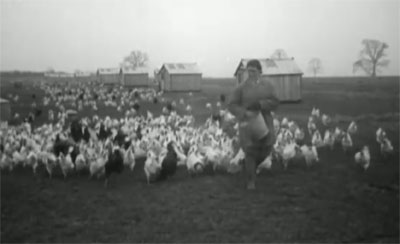

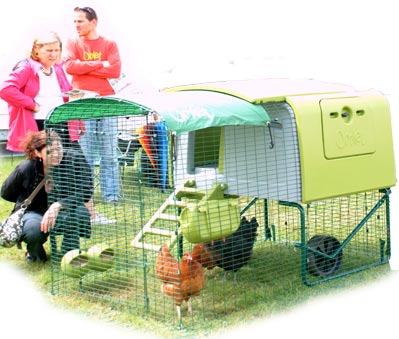


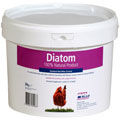
Chicken feed? We have three healthy hens (Rhode Rock, Light Sussex, Blue Belle) which we have had for a year (they are by now about 19 – 20 months old I suppose). Until six weeks ago they were all laying well, but seemed to suddenly stop. An occasional soft-shelled egg (laid off the perch during the night) is all that is being produced.
They are fed layers’ pellets, have access to grit, plenty of fresh water (with added tonic), no red mite or worms, and are free to range around the garden during the day.
They are not moulting, yet egg production has ceased. I can find no obvious reason (and I’m happy for them to have a rest) but six weeks of no production seems a little odd to me.
Do you think it could be the feed, the time of the year, or perhaps a disease that I have been unable to detect?
Thoughts welcome!
It is most likely to be the time of year. They will decrease egg production now that the daylight hours are decreasing and many will stop laying before they go into moult. Pullets in their first year will lay further into the winter – and won’t usually moult the first year. They should all start laying again after the Winter.
With the warm autumn we’re having, one thing you could check is that there aren’t red mite in the coop. You won’t normally find these on the birds but soon cause birds to stop laying.
Thanks very much. I’ll have a good look at them again.
Hello 🙂
I have got three Plymouth Rocks, two Light Sussex, one black Rock (only one laying an egg a day) all are 27 weeks old. Iam now getting two Pekin pullets as I would like to use them sometimes as broodies to keep up a regular supply of hens in the future.
Could you please let me know what I should feed the two Pekins which are both 12 weeks old? I will be keeping both Pekins in a separate coop which I specially did build for them 🙂
Your reply is very much appreciated and also thank youy so very much for your great website 🙂
You should be feeding Growers Pellets until 18 to 20 weeks old. These have higher levels of protein for growth.
Hi
I just bought 4 warren chickens about 6 months old. There were laying at there previouse owners.
He fed them layers pellets and layers mash daily and with grit once a week and corn once a day.
Is this ok?
No need to feed both mash and pellets, both are the same thing nutritionally so pellets or mash ad lib in a feeder should be fine. Grit should be available ad lib. Only a handful of corn per day, per bird though – remember it’s a treat.
Is it ok to give hens grass from mowing the lawn? What about cutting some from around my rather scruffy allotment – how long can it be? I thought it wasn’t good for them to have grass that is too long. Thanks
The problem you will have heard about is long stems of grass impacting (blocking) the crop which is one reason to cut grass short where chickens graze. Yes, it’s fine to give grass clippings to chickens. Long grass has little nutritional value for them and is tough and woody. Short, lush green grass is what you want to provide.
Hello! I have 6 chickens, they are 24weeks old, 2 of which are laying! They eat just the layers pellets thoughout the day then in the afternoon I will feed a few handfuls of corn and either cabbage or cooked pasta. A few times a week I collect a bowlful of short fresh grass and weeds. Does this diet sound ok or is there more I should be doing?
Sounds great! Just go easy on the pasta (lots of Carbohydrate, not a lot else) and make sure there is insoluble (flint) grit for them to take if they need it for digestion. Sometimes they can get this from the ground when they free range but not all soils contain the right sort of grit.